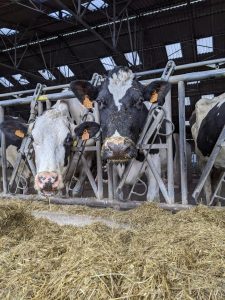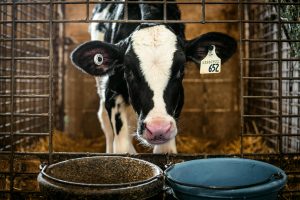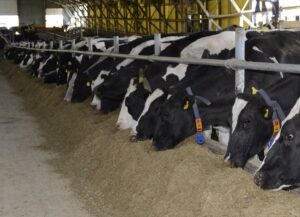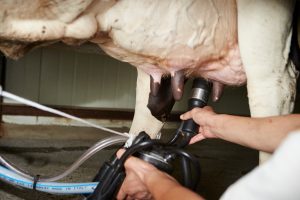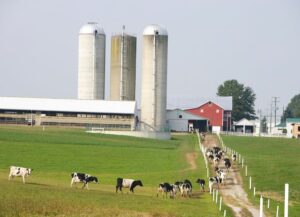Álvaro García
For generations, small family dairies raised calves in simple setups: one bucket for milk, another for grain, and a stake or rope to keep the calf in place, often close enough to see other animals, but too far to interact. In some pasture-based systems of the world, even nowadays, calves are tethered to a stake in the ground—close enough to see and hear one another, but too far apart to touch or interact. The idea is straightforward: prevent nursing from other cows, make feeding predictable, and reduce the risk of spreading disease. These methods were devised out of necessity and practicality, especially when labor and resources were limited.
Yet, under these conditions, calves have little opportunity for social interaction. They could see and hear other animals but rarely touch or play with them. Over time, we’ve come to understand that this kind of isolation, though unintentionally, delay behavioral development. Social behaviors like grooming, play, and mutual resting aren’t just nice extras, they help shape how calves learn, eat, and respond to the stress of herd life later.
Today’s research confirms what many farmers have observed anecdotally: calves raised with companions tend to be more adaptable and eat better, particularly as they transition to solid feeds. As dairy systems modernize, interest is growing in how early social housing can promote both calf well-being and long-term performance within the herd. (Miller-Cushon & Jensen, 2025).
Benefits of early social housing
Social housing of young calves, especially when introduced early in life, can positively influence their behavior, growth, and health. Calves raised with one or more companions show more natural behaviors like grooming, playing, and exploring. These interactions are not just signs of well-being but are part of how calves learn and adapt to new environments. Social contact also helps reduce abnormal behaviors, such as cross-sucking, which can lead to issues like navel infections or udder damage later. From a performance standpoint, calves housed in pairs or small groups tend to eat more solid feed and transition more easily during weaning. This increased intake typically translates into better weight gain compared to calves kept alone. While many farmers worry about disease spread when calves are grouped, research shows that, with good hygiene and ventilation, social housing does not harm calf health, and in some cases may even improve it by reducing stress and encouraging more consistent feeding patterns.
Key management factors
Successfully raising socially housed calves depends on a few key management practices. First, the size and makeup of the group matter. Housing calves in small groups, typically between two and seven, tends to support better feeding behavior and more consistent growth. When calves are close in age, they compete less and settle into routines more easily, reducing stress for both animals and caretakers.
The housing environment also plays an important role. Calves need enough space to move, lie down comfortably, and express natural behaviors like playing. Crowding not only limits physical development but can also raise stress levels. Adding simple enrichments, like a brush to scratch against or a soft object to chew, helps redirect energy in positive ways and cuts down on undesirable habits like licking or sucking on pen mates.
To get the most out of social housing, it’s best to pair or group calves early, ideally within the first week of life, before strong habits of isolation form. Keeping a close eye on health is critical, especially during the adjustment period. Good ventilation, clean bedding, and consistent observation are essential to prevent disease. Groupings should also consider each calf’s health status and temperament. Some animals may need more time to adjust or may be better suited to calmer companions. With thoughtful planning and a watchful eye, social housing can be both practical and beneficial on farms of all sizes.
Research indicates that the optimal group size for pre-weaned dairy calves in group housing systems typically ranges between four and eight calves per pen. This range appears to offer the best balance between social interaction and manageable competition for food and space. Calves housed in small groups, particularly those with four to seven animals, show improved feeding behavior, better weight gain, and lower stress levels compared to those in larger groups. These benefits are partly due to reduced competition and the opportunity for natural social interactions like play and mutual grooming. Larger group sizes, such as 12 to 18 calves per pen, may encourage some natural behaviors but also increase the risk of competition, uneven feed access, and higher stress, which can compromise health and growth performance. Starting with pair housing and gradually transitioning to small groups can help calves adapt more easily to social environments. Monitoring calf behavior and health regularly is key to adjusting group sizes and maintaining effective management practices on-farm.
Creating the right environment for calves
Providing calves with the right environmental conditions is just as important as how they are housed socially. Even the benefits of group housing can be undermined if calves are cold, damp, or stressed by poor air quality. A comfortable, clean, and well-ventilated space helps reduce disease risk, supports better feed intake, and ensures calves grow to their full potential.
Calves thrive within a thermoneutral zone, roughly 55 to 75°F (13 to 24°C) for newborns and 50 to 78°F (10 to 25°C) for older calves. Temperatures below this range force the calf to burn more energy just to stay warm, which can compromise growth unless extra nutrition is provided. During colder months, deep straw bedding, windbreaks, and calf jackets can help retain warmth. In warmer weather, it’s important to offer shade and increase ventilation to prevent heat stress.
Air quality and movement also play a major role. Good ventilation removes humidity, gases, and pathogens without creating drafts. In winter, aim for 4 to 6 air changes per hour, and in summer, increase this to 40 to 60 changes per hour to control heat and humidity. Air speed at calf level should remain below 2 meters (6 feet) per second to avoid chilling. In enclosed barns, positive-pressure ventilation tubes can provide consistent, fresh air at the calf’s level without direct drafts.
Moisture control is key to preventing respiratory issues and keeping bedding dry. Relative humidity should stay below 75%, especially when temperatures drop and buildings are more closed up. Bedding should be dry and thick enough to allow calves to nest—ideally 3 to 4 inches deep (7.5-10 cm). Straw is a preferred bedding material in colder climates, as it offers better insulation. In warmer regions, wood shavings or sand can be used, provided they remain clean and dry.
These environmental details—temperature, airflow, humidity, and bedding—set the foundation for healthy calf development and help maximize the benefits of early social housing.
Raising healthy, well-adjusted calves start long before they enter the milking string, it begins in those early weeks when their habits, resilience, and social instincts take shape. While traditional calf-rearing systems prioritized convenience and disease control, they often did so at the cost of social development. Today’s research and on-farm experience both point in the same direction: calves benefit from growing up with companions.
Social housing isn’t just a trend that shifts toward recognizing the calf as a social animal whose development depends on interaction, comfort, and mental stimulation. When properly managed, grouping calves supports stronger feeding behavior, better growth, and a smoother transition to group life later. And far from compromising health, a clean and well-ventilated group setting can match or even surpass individual housing in promoting calf well-being.
© 2025 Dellait Knowledge Center. All Rights Reserved.




